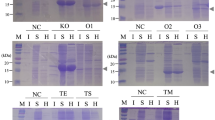Abstract.
Streptococcus thermophilus is widely used in food fermentations; it commonly suffers diverse stress challenges during manufacturing. This study investigated the cold shock response of S. thermophilus when the cell culture temperature shifted from 42°C to 15°C or 20°C. The growth of cells was affected more drastically after cold shock at 15°C than at 20°C. The generation time was increased by a factor of 19 when the temperature was lowered from 42° to 20°C, and by a factor of 72 after a cold shock at 15°C. The two-dimensional electrophoretic protein patterns of S. thermophilus under cold shock conditions were compared with the reference protein pattern when cells were grown at optimal temperature. Two proteins of 21.5 and 7.5 kDa synthesized in response to cold shock were characterized. N-terminal sequencing and sequence homology searches have shown that the 7.5-kDa protein belonged to the family of the major cold shock proteins, while no homology was found for the new cold shock protein of 21.5 kDa.
Similar content being viewed by others
Author information
Authors and Affiliations
Additional information
Received: 4 June 1999 / Accepted: 6 July 1999
Rights and permissions
About this article
Cite this article
Perrin, C., Guimont, C., Bracquart, P. et al. Expression of a New Cold Shock Protein of 21.5 kDa and of the Major Cold Shock Protein by Streptococcus thermophilus After Cold Shock. Curr Microbiol 39, 342–347 (1999). https://doi.org/10.1007/s002849900469
Issue Date:
DOI: https://doi.org/10.1007/s002849900469




